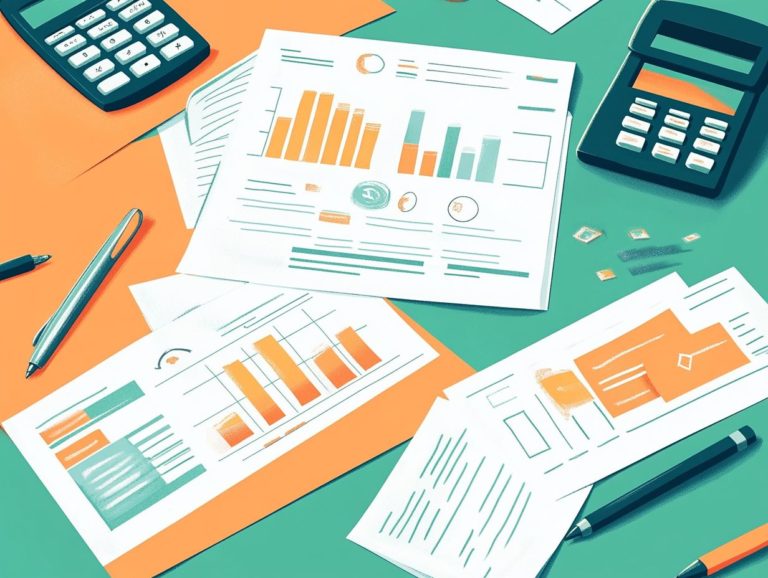What is the Freelancer’s Guide to Quarterly Taxes?
Quarterly taxes can confuse freelancers. Understanding them is essential for financial success as a self-employed individual.
This guide covers all aspects of quarterly taxes freelancers need to know. Important considerations include tax deductions and their impact on your overall tax burden.
- What quarterly taxes are
- Who is required to pay them
- How to calculate quarterly tax payments
- Relevant deadlines, dates, and penalties
It offers practical ways to meet your quarterly tax obligations. Additional resources will help you manage quarterly taxes effectively.
Contents
- Key Takeaways:
- Understanding Quarterly Taxes for Freelancers
- Who Needs to Pay Quarterly Taxes?
- Calculating Quarterly Tax Payments
- Quarterly Tax Deadlines
- How to File Quarterly Taxes
- Tips for Managing Quarterly Taxes as a Freelancer
- Strategies for Budgeting and Avoiding Penalties
- Resources for Freelancers Filing Quarterly Taxes
- Frequently Asked Questions
Key Takeaways:
- Freelancers must pay quarterly taxes if they expect to owe at least $1,000 in federal taxes for the year as mandated by the IRS.
- Quarterly taxes are calculated based on estimated income and expenses. This is crucial for accurately assessing the amount you owe.
- Stay organized and plan ahead to avoid penalties and manage your tax payments effectively!
Understanding Quarterly Taxes for Freelancers
Quarterly taxes are important for freelancers and self-employed individuals. They relate directly to freelance income.
Freelancers need to estimate their taxable income for the year. Making quarterly payments helps avoid a large tax bill from the IRS.
The IRS (Internal Revenue Service) mandates that anyone self-employed and earning over $1,000 must file quarterly estimated taxes. This typically involves using Form 1040-ES for accurate deductions.
Using bookkeeping software like FlyFin A.I. simplifies this process. It helps freelancers manage tax obligations and reduce taxable income effectively!
What are Quarterly Taxes?
Quarterly taxes are estimated payments made four times a year to the IRS. They help cover anticipated tax liabilities and avoid penalties.
Payments are due in April, June, September, and January of the following year. These are key deadlines for freelancers to ensure compliance with federal regulations.
Who Needs to Pay Quarterly Taxes?
Individuals who owe $1,000 or more in taxes after accounting for withholding must make estimated tax payments to the IRS. This includes freelancers, independent contractors, and those with side gigs.
It’s essential for freelancers to know if they need to pay quarterly taxes. Tax professionals can provide clarity on individual situations!
Determining if You are Required to Pay
To check how much tax you might owe, you must consider all your income sources, including freelance work, Social Security benefits, and other self-employed income. Start by estimating the total income you anticipate earning for the year. While this may be straightforward for a single freelance project, you also need to consider any additional income, such as investment earnings or part-time jobs, including contributions to a 401(k) or an individual retirement account.
Next, estimate any deductible tax expenses, as this will help reduce your taxable income with appropriate tax deductions—money you can subtract from your income to lower your tax bill. Identifying deductible expenses, such as office supplies, travel costs, or software subscriptions, can significantly lower the amount of tax you owe. According to the IRS, if you expect to owe $1,000 or more, you will likely need to make estimated payments to avoid tax penalties.
Maintaining accurate records of your income and expenses can facilitate this assessment and ensure compliance with your tax obligations.
Calculating Quarterly Tax Payments
Calculating quarterly tax payments is particularly important for self-employed workers and freelancers, as missing your quarterly tax payments can lead to hefty penalties. Typically, this process involves estimating total income, deducting any applicable tax deductions, and determining the total estimated tax owed for the year using a tax calculator.
Once the total tax owed is calculated, it can be divided by four to establish the quarterly payment amount, ensuring consistency in payment methods. Digital tax calculators save time and improve accuracy, making it easier for freelancers to manage their finances effectively.
Methods for Calculating and Estimating Payments
There are several methods for calculating and estimating quarterly tax payments, including tax calculators and IRS guidelines for projecting income and allowable tax deductions. For many freelancers, infrequent tax planning can lead to unexpected tax liabilities and penalties.
One approach to tax planning involves manually calculating estimated taxes by gathering records of income and deductions, which allows for a more personalized estimate. Alternatively, freelancers can use digital tax calculators, which facilitate easy input of financial information for automatic calculations.
Regardless of the method chosen, regularly monitoring income and expenses is essential for freelancers. This practice enables them to obtain an accurate estimate of their tax liability, ensuring that deductions are properly claimed and preventing any surprises at the end of the year.
Quarterly Tax Deadlines
Quarterly tax deadlines are crucial for freelancers and self-employed individuals to adhere to. Missing these deadlines can lead to significant tax penalties from the IRS, impacting a freelancer’s tax burden. Typically, quarterly taxes are due on the 15th of April, June, September, and January.
Being aware of these dates can help you avoid missing a payment and ensure timely tax return submissions. Start calculating your quarterly taxes today to keep your finances under control!
Important Dates to Remember
Important dates for quarterly taxes are the deadlines for estimated tax payments set by the IRS. These dates are crucial for freelancers and self-employed individuals to reduce taxes. These deadlines occur four times a year, typically on April 15, June 15, September 15, and January 15 of the following year, so freelancers should note them carefully.
Writing these dates down can make tax time stress-free! Setting reminders will help you avoid any last-minute rush to meet these deadlines, making it easier to manage tax payments. Taxpayers should base their estimated tax payments on last year’s income or their projected income. Be sure to consider any changes in income sources, including freelance work.
Monitoring your financial records year-round will assist in this process. This enables taxpayers to make necessary adjustments and helps avoid fines for not paying enough taxes, especially for freelancers with variable income.
How to File Quarterly Taxes
Quarterly taxes are payments made to the IRS throughout the year based on a specific schedule that all freelancers must adhere to. These payments are particularly important for self-employed individuals, as they help ensure compliance with federal tax laws, including contributions to Social Security and Medicare.
Steps for Submitting Tax Payments
Here are the steps for submitting tax payments for quarterly taxes to ensure accuracy and compliance:
- Determine the Amount Owed: The amount owed during quarterly tax periods is based on your estimated income for the year and should include all forms of income, including freelance income. The IRS provides a worksheet in Form 1040-ES to assist in calculating your estimated tax payments, especially useful for freelancers. You can access the 2023 Form 1040-ES worksheet here, which includes instructions for deducting expenses.
- Select a Payment Method: The IRS offers several options for paying quarterly taxes, including various payment methods that freelancers should consider.
- Direct Pay: This is a free electronic payment service that allows individuals to pay their tax bill or estimated tax directly from their checking or savings account, which is often convenient for freelancers.
- Debit or Credit Card: Payments can be made using a debit or credit card, though users will incur service fees set by the card processor, another method freelancers can utilize.
- Mail a Check: You can file a payment voucher, Form 1040-ES, along with a check for the amount owed to ensure proper documentation.
- Note Deadlines: Being aware of the due dates for estimated tax payments helps you avoid late fees and keep your tax payments organized. Don’t wait—mark your tax deadlines today!
- Track Your Submission: Save any emails or receipts from your payment method as proof of submission—this is essential for freelancers during tax season.
- Keep Records: Maintaining records of your quarterly tax payments and any correspondence with the IRS can simplify the process during tax season, especially for self-employed individuals.
- Review and Double-Check Entries: Before submitting, review all entries to ensure accuracy and avoid potential complications in the future.
Tips for Managing Quarterly Taxes as a Freelancer
Effective strategies for managing quarterly taxes as a freelancer include implementing sound bookkeeping practices and consulting with tax professionals and a bookkeeper. This can lower your tax burden and simplify the management of quarterly taxes.
Utilizing bookkeeping software, like FlyFin A.I., ensures that accurate records of income and expenses are maintained, including documentation for any tax deductions to which a freelancer may be entitled. Consulting professionals can help freelancers optimize their tax situations and reduce overall tax liability.
Start tracking your income and expenses now for a smoother tax season!
Strategies for Budgeting and Avoiding Penalties
Effective budgeting strategies for freelancers to manage quarterly taxes include proactively selecting income sources, estimating tax liabilities, and meticulously tracking expenses. By monitoring their expenses, freelancers can lower their taxable income by deducting business-related costs, which reduces the total taxes they owe.
Choosing income sources wisely can also help freelancers minimize their tax burden by providing access to lower-tax alternatives that aid in meeting tax obligations.
Estimating tax obligations allows freelancers to determine their income sources and allocate the right amount for taxes. This ensures they have the necessary funds available when payments are due.
Freelancers should consider setting aside a percentage of their regular income in a separate savings account designated solely for tax payments.
Common issues that can lead to budgeting inefficiencies include failing to account for variable income and neglecting to consult a tax professional. Not considering variable income can result in setting aside too little for taxes, leading to underpayment penalties that negatively impact cash flow.
To improve financial management, freelancers should establish a regular schedule for reviewing their financial commitments and obligations. This provides a clearer picture of their financial health and helps avoid last-minute adjustments.
Resources for Freelancers Filing Quarterly Taxes
Freelancers can tap into a variety of resources that make filing quarterly taxes easier. These include bookkeeping software, tax calculators, and the support of tax professionals, all of which help streamline the process.
Helpful Tools and Services for Tax Preparation
Tools and services for tax preparation include advanced bookkeeping software, tax calculators, and consulting services from tax professionals. These resources assist freelancers in managing their quarterly taxes more efficiently.
Utilizing technology significantly enhances the tax filing experience, making it more streamlined and less stressful. For example, FlyFin A.I. offers powerful, artificial intelligence-driven insights that help freelancers track expenses intelligently, ensuring that no deductible costs go unnoticed.
Intuitive tax calculators allow for quick calculations, making it easy for freelancers to estimate their taxable income and potential returns.
Engaging in professional consultations can provide personalized strategies tailored to specific financial situations. This equips freelancers with best practices to maximize deductions and minimize liabilities while navigating complex tax regulations confidently.
Frequently Asked Questions
What is the Freelancer’s Guide to Quarterly Taxes?
The Freelancer’s Guide to Quarterly Taxes is a comprehensive resource for self-employed individuals or freelancers who need guidance on how to pay their taxes quarterly.
Who is required to pay quarterly taxes?
Self-employed individuals, freelancers, and independent contractors whose estimated tax liability for the year is greater than $1,000 are required to pay quarterly taxes.
What are quarterly taxes?
Quarterly taxes are payments made by self-employed individuals every three months to cover their income taxes and the taxes for working for yourself.
Why do I need to pay quarterly taxes?
As a self-employed individual, you must pay your own taxes throughout the year. This is different from traditional employees, who have taxes automatically withheld from their paychecks. Quarterly taxes help you avoid a large tax bill at the end of the year and possible penalties for underpayment.
How do I calculate my quarterly taxes?
To calculate your quarterly taxes, estimate your income and deductible expenses for the year, as well as your self-employment tax rate. You can use the IRS Form 1040-ES to help you determine your estimated tax liability, which is the amount of tax you think you will owe for the year.
When are quarterly taxes due?
Quarterly taxes are due on the 15th of April, June, September, and January of each year. If the due date falls on a weekend or holiday, the deadline is extended to the next business day.
Don’t wait until the last minute to prepare your taxes; start planning now to avoid stress later!










